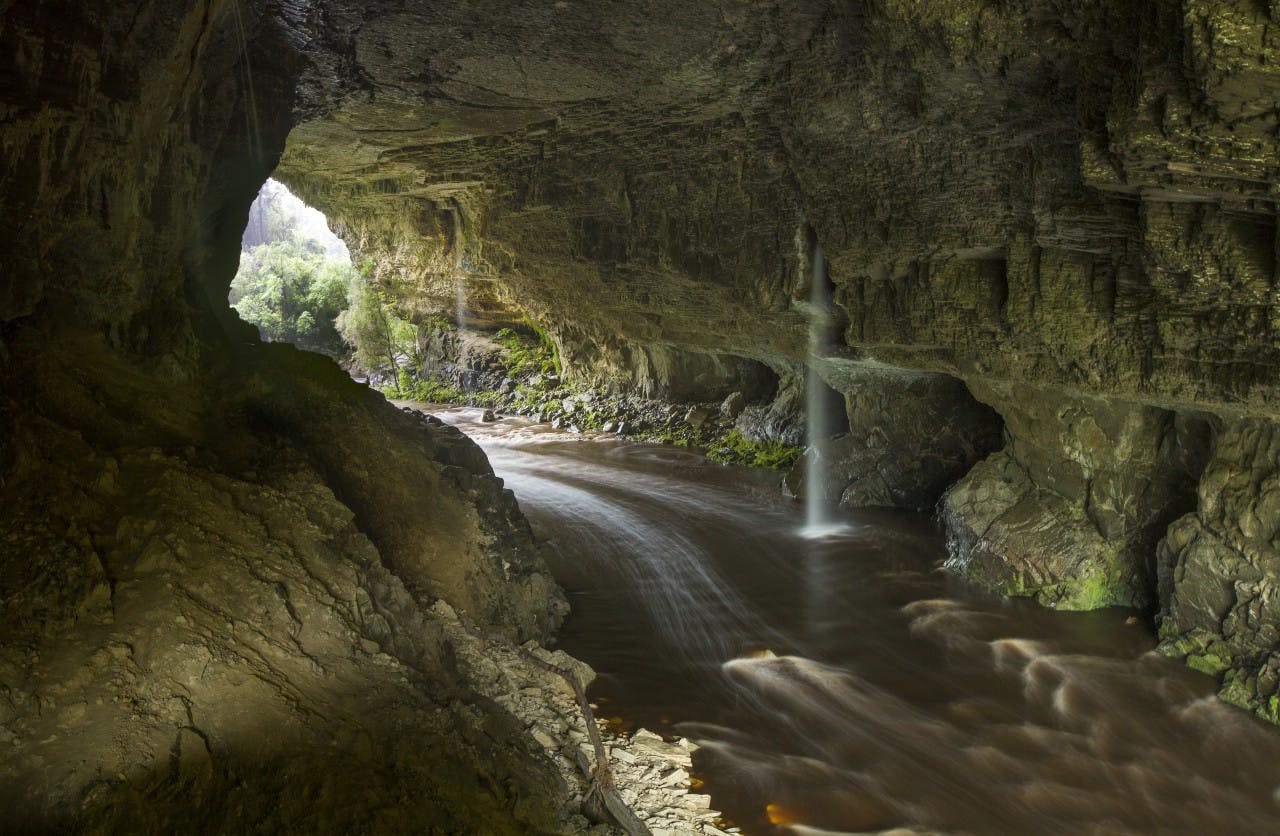In an effort to enhance and promote the Oparara Basin on the West Coast, DOC is considering a design plan which may include building a walkway, creating a light show and installing lifesize moas in the Oparara Arches.
“It’s an incredibly beautiful place,” West Coast photographer, caver, and outdoor instructor Neil Silverwood said of the basin, which is full of unmodified native bush, with the tannin-stained Oparara River snaking its way through limestone formations. There’s over 10km of limestone, and what Silverwood calls “world class karst”, which is landscape formed by the dissolution of soluble rocks; essentially, water flowing beneath high quality limestone, creating, “an incredible concentration of caves.”
The arches are along a system of tracks through the basin, and are about 15 minute’s walk from the road-end car park.
“There’s a really great system of walkways, created by the Oparara Trust, linking the arches, and also taking you to two caves: Box Canyon and Crazy Paving Cave. Beyond there is the specially restricted area of the Honeycomb Hill Cave system, with the largest deposit of subfossil remains in New Zealand,” Silverwood said. “Going into there, it’s a little bit like walking into a museum.”
Oparara, while unique, isn’t on the regular tourist track. It’s at the end of the road on the northern West Coast and receives around 20,000 visitors a year – much less than hotspots like Punakaiki which gets 500,000 visitors.
According to DOC’s Westport operations manager Bob Dickson, the West Coast Regional Growth Study targeted Tourism West Coast to find ways to boost tourism on the northern West Coast. Part of the proposal for Oparara includes erecting cell phone towers nearby to ‘create perfect selfie opportunities, to capitalise on social media and selfie-taking to promote Oparara.’
“The northern part of the West Coast is hurting from the loss of extractive industry and closure of the big cement manufacturer, Holcim. Things are a bit grim around here,” Dickson said.
Because DOC manages Kahurangi National Park, where the arches are located, it stepped in to see how it could help develop Oparara. Mick Abbott, Head of the School of Landscape Architecture at Lincoln University, was asked to develop a draft proposal for the Oparara enhancements. The objective, Abbott said, was to promote knowledge of the area’s former moa population. The proposal suggests that Karamea could be branded ‘Moa Town’, with the extinct bird also being a key feature of Oparara Arches.
“What we want to do is draw people to the Oparara to discover the story of moa and learn about what’s taking place in the region with kiwi and whio, because our challenge is to take the story of moa and make sure there’s no more extinctions. That’s the front and centre message.”
The proposal includes developing a new walkway that will be bolted into the limestone, erecting lifesize moas along the walkway, and designing a light show that would cast the shapes of Haast eagles and moa onto the limestone walls.
“It will only work when someone is there – someone would have to put their hand over an iPad-type thing, and a bird would come out of the crack and fly out at the end of the cave,” Abbott said. “People go through using torches as it is, so we are trying to mimic that use of torches.”
Silverwood, a member of the NZ Speleological Society, sees the proposal as heavy-handed. “It’s very out of sync with the natural balance,” he said.
A specific concern of Silverwood’s is that the caves are a “hot spot” for the rare Spelungula spider, which at 15cm long is the largest spider in New Zealand. The proposed light shows and increased visitors could have a negative impact on the spider’s habitat, Silverwood said.
However, Dickson said environmental concerns, such as the spider’s protection, will come first when considering any developments.
“There needs to be further thought and investment,” he said. “Are these concepts workable, can we mitigate the risks, and what is the carrying capacity.” Dickson said the Nelson Conservation Board and the NZ Speleological Society would be contacted for input.
“It’s a relatively small footprint,” Dickson said. “We think it is innovative, experiential and exciting and will offer some very strong conservation messages to the public.”
Dickson will be presenting DOC’s suggestions to the Ministry of Business by early March. While he’s supportive of promoting the area, he’s skeptical the Oparara Arches proposal will greatly increase tourism to the northern West Coast.
“I just don’t think we’re going to get vast numbers of people there. In spite of some of the figures I’ve seen, I can’t imagine their reality.”






